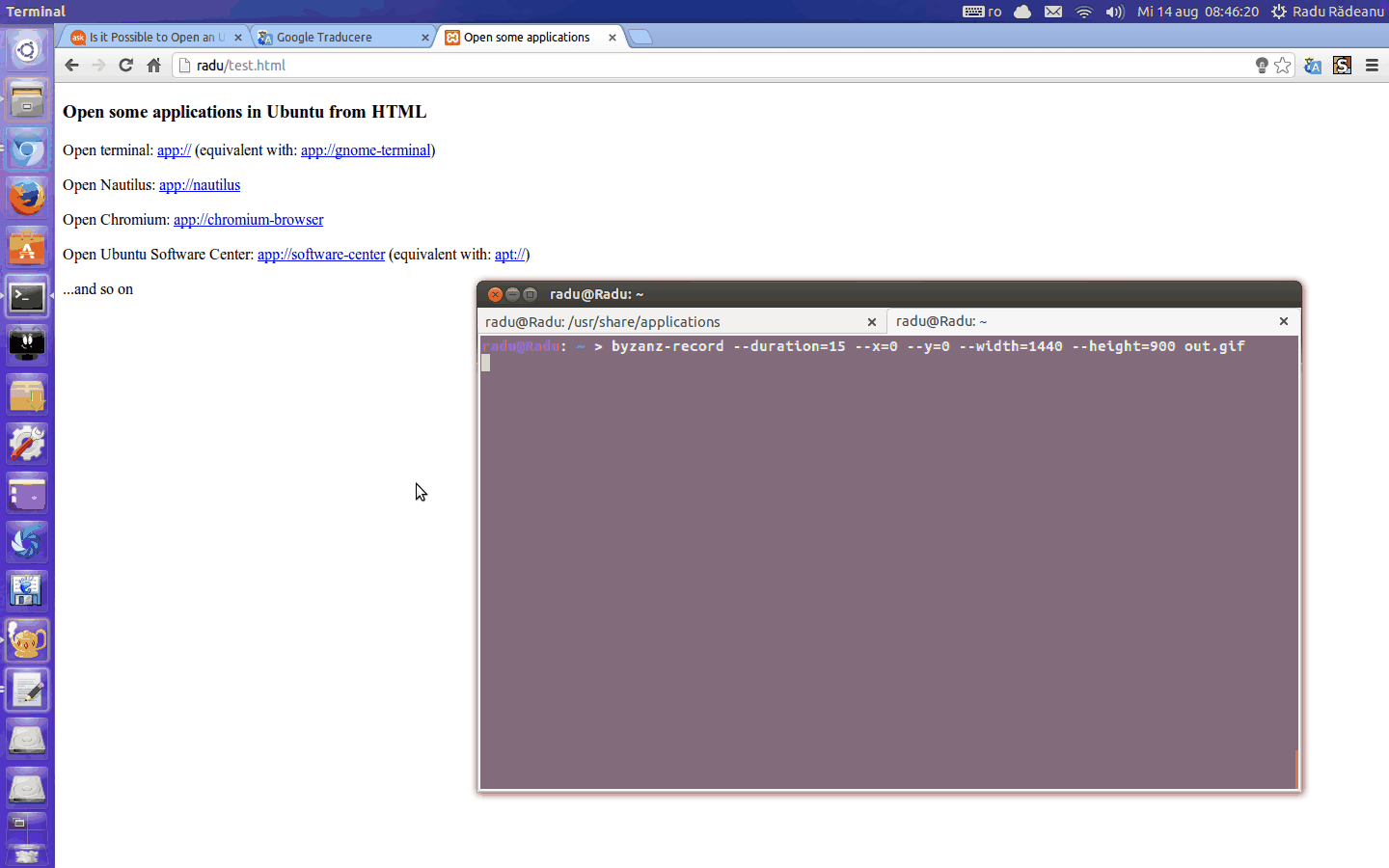Is it possible to open an Ubuntu app from HTML?
I'm creating a webpage right now and am wondering if it is possible to input a command in HTML that will open an installed Ubuntu app like Chromium, or a terminal window, or Nautilus.
Is something like this possible? Thanks!
Solution 1:
Yes, you can by adding a new protocol handler in your Ubuntu. The following method will show you how to register the process of opening an application as app://[application_name] protocol handler in Ubuntu.
1. Create application launcher script
-
In a terminal run:
mkdir -p binThis command will make a
bindirectory in yourhomefolder if you don't already have it. -
After run:
gedit ~/bin/open_app.shThis will create the new file
open_app.shin gedit. -
Copy and paste the following script in the new created file:
#!/bin/bash if [[ "$1" != "app://" ]]; then app=${1#app://} nohup "$app" &>/dev/null & else nohup gnome-terminal &>/dev/null & fi Save the file and close it.
-
Go back into terminal and run:
chmod +x ~/bin/open_app.shto grant execute access for the script.
2. Create .desktop file for application launcher
Now you must create a .desktop launcher for the above script, and tell Ubuntu to use this launcher as app:// protocol handler. Create /usr/share/applications/appurl.desktop file using the following command:
sudo -H gedit /usr/share/applications/appurl.desktop
and add the following content:
[Desktop Entry]
Name=TerminalURL
Exec=/home/radu/bin/open_app.sh %u
Type=Application
NoDisplay=true
Categories=System;
MimeType=x-scheme-handler/app;
Save the file and close it.
3. Refresh mime types database
In the file above, the line MimeType=x-scheme-handler/app; register app:// scheme handler, but to make it work we should update mime types database cache by executing command:
sudo update-desktop-database
4. Test from terminal
Now everything should work. To test that it works from terminal, run for example this command:
xdg-open 'app://gedit'
4. Test from browser using HTML
You can test from browser by using for example the following HTML web page:
<!DOCTYPE html PUBLIC "-//W3C//DTD XHTML 1.0 Strict//EN"
"http://www.w3.org/TR/xhtml1/DTD/xhtml1-strict.dtd">
<html xmlns="http://www.w3.org/1999/xhtml" xml:lang="en" lang="en">
<head>
<title>Open some applications</title>
<meta http-equiv="content-type" content="text/html;charset=utf-8" />
</head>
<body>
<h3>Open some applications in Ubuntu from HTML</h3>
<p>Open terminal: <a title="Open" href="app://">app://</a>
(equivalent with: <a title="Open" href="app://gnome-terminal">app://gnome-terminal</a>)</p>
<p>Open Nautilus: <a title="Open" href="app://nautilus">app://nautilus</a></p>
<p>Open Chromium: <a title="Open" href="app://chromium-browser">app://chromium-browser</a></p>
<p>Open Ubuntu Software Center: <a title="Open" href="app://software-center">app://software-center</a>
(equivalent with: <a title="Open" href="apt://">apt://</a>)</p>
<p>...and so on</p>
</body>
</html>
The result:

Solution 2:
Yes, it is called "Web-based protocol handlers". You need Chrome 13 or Firefox 3.0 or higher. I have seen it used to open LibreOffice.
Both Mozilla and updates.html5rocks have an explanation about how this works. (Open in Chrome/Chromium chrome://settings/handlers and it will show a list of current handlers. Firefox will list them in about:config.)
Parts from the 1st link:
Registering
Setting up a web application as a protocol handler is not a difficult process. Basically, the web application uses registerProtocolHandler() to register itself with the browser as a potential handler for a given protocol. For example:
navigator.registerProtocolHandler("mailto",
"https://www.example.com/?uri=%s",
"Example Mail");
Where the parameters are:
- The protocol.
- The URL template, used as the handler. The "%s" is replaced with the href of the link and a GET is executed on the resultant URL.
- The user friendly name for the protocol handler.
When a browser executes this code, it should display a prompt to the user, asking permission to allow the web application to register as a handler for the protocol. Firefox displays a prompt in the notification bar area.
Example
<!DOCTYPE HTML PUBLIC "-//W3C//DTD HTML 4.01//EN">
<html lang="en">
<head>
<title>Web Protocol Handler Sample - Register</title>
<script type="text/javascript">
navigator.registerProtocolHandler("fake", "http://starkravingfinkle.org/projects/wph/handler.php?value=%s", "Fake Protocol");
</script>
</head>
<body>
<h1>Web Protocol Handler Sample</h1>
<p>This web page will install a web protocol handler for the <code>fake:</code> protocol.</p>
</body>
</html>